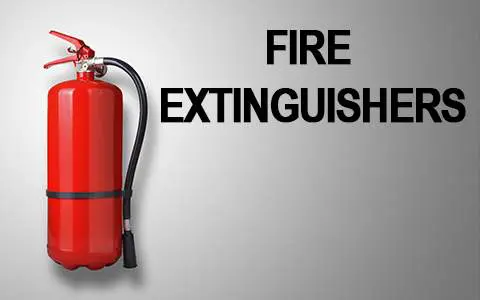 Everyone should have a fire extinguisher in their home, the question is what type. From water to foam to carbon dioxide there are many to choose from. Lets look at the Fire Extinguisher Types so we know what types are best for home use.
Everyone should have a fire extinguisher in their home, the question is what type. From water to foam to carbon dioxide there are many to choose from. Lets look at the Fire Extinguisher Types so we know what types are best for home use.
Fire Conditions
When a fire occurs, it is highly likely that there will be damage to the area where the fire is and to any life as well. the potential for damage to people and property is tremendously high. For a fire to exist there are 4 needs for a fire.
- Fuel – Common type include wood, coal, natural gas, paper.
- Oxygen – Fire needs oxygen to exist and there is only a few places where there is no oxygen on earth.
- Heat – For a fire to start a heat source needs to start the chemical reaction. Common sources are flame, a spark or even a high temperature.
- Combustion – The transformation of the fuel and oxygen include the byproducts of heat and light. The heat keeps the reaction going until fuel or oxygen are not present.
Fire Types
There are 4 main classes of fires.
- Class A – Ordinary Combustibles
- Wood, paper, cloth
- Ordinary trash
- Class B – Flammable Liquids and Gases
- Gasoline
- Oils
- Paints
- Propane
- Class C – Fires involving electrical equipment – these could be any of the other type of fires, but electrical equipment is involved
- Class D fires – Combustible Metals and Metal Alloys (not very common)
Fire Extinguishers
Water and Foam
Water and Foam fire extinguishers extinguish the fire by taking away the heat element of the fire triangle. Foam agents also separate the oxygen element from the other elements.
Water extinguishers are for Class A fires only – they should not be used on Class B or C fires. The discharge stream could spread the flammable liquid in a Class B fire or could create a shock hazard on a Class C fire.
Carbon Dioxide
Carbon Dioxide fire extinguishers extinguish fire by taking away the oxygen element of the fire triangle and also be removing the heat with a very cold discharge.
Carbon dioxide can be used on Class B & C fires. They are usually ineffective on Class A fires.
Dry Chemical
Dry Chemical fire extinguishers extinguish the fire primarily by interrupting the chemical reaction of the fire triangle.
Today’s most widely used type of fire extinguisher is the multipurpose dry chemical that is effective on Class A, B, and C fires. This agent also works by creating a barrier between the oxygen element and the fuel on Class A fires.
Ordinary dry chemical is for Class B & C fires only. It is important to use the correct extinguisher for the type of fuel! Using the incorrect agent can allow the fire to re-ignite after apparently being extinguished succesfully.
Clean Agent
Halogenated or Clean Agent extinguishers include the halon agents as well as the newer and less ozone depleting halocarbon agents. They extinguish the fire by interrupting the chemical reaction and/or removing heat from the fire triangle.
Clean agent extinguishers are effective on Class A, B and C fires. Smaller sized handheld extinguishers are not large enough to obtain a 1A rating and may carry only a Class B and C rating.
Dry Powder
Dry Powder extinguishers are similar to dry chemical except that they extinguish the fire by separating the fuel from the oxygen element or by removing the heat element of the fire triangle.
However, dry powder extinguishers are for Class D or combustible metal fires, only. They are ineffective on all other classes of fires.
We hope that this will help you with what Fire Extinguisher Types you should have in your home. If you have any questions about fire safety check out the Canadian Fire Safety Association.
